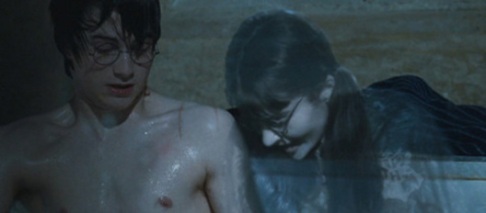Moaning Myrtle is often seen as a minor character in the Harry Potter series. However, she embodies many of the underlying stresses and struggles of student life. She is a ghost that haunts the women’s bathroom where she died during her time at Hogwarts. During her education at Hogwarts, she was sorted into Ravenclaw house, was unable to make any friends, and was often subject to bullying by her peers. The night of her death, Myrtle ran to the bathroom crying as a result of teasing and witnessed the opening of the Chamber of Secrets. Tom Riddle, the person who opened it, commanded the basilisk inside to stare at Myrtle, which led to her demise. As a result, Myrtle haunts the stall where she died.
Society has always been fascinated with the supernatural, especially that of haunted places or objects. In particular, the time period during which we are in school is one that is filled with countless stories of the supernatural. Such “student ghosts” have reality anchors that make them relatable to regular students but also have morbid characteristics that render them horrific. In the case of Moaning Myrtle from the Harry Potter series, she is the spirit of a previous student who was just like any other person, save for her gruesome fate of murder in the bathroom. The character of Moaning Myrtle most clearly embodies monstrosity as a being suffering from Cohen’s category crisis. As stated by Behr, the character of Moaning Myrtle occupies a unique limbo between toilet humor and the horror of homicide. The juxtaposition of Myrtle’s light-hearted toilet haunting and her tragic and lonesome demise draws out conflicted feelings in the audience. Do we feel sad for the death of such a young girl or do we laugh at her antics as a ghost? In addition to this, there is a constant questioning of whether Myrtle is a “good” and “helpful” ghost or one that is a troublemaker. The neutral actions/character of Myrtle puts her in a liminal space that does nothing but reinforce the monstrosity of “matter out of place” or category crisis. It can also be said that Moaning Myrtle represents the timeless dichotomy of horror and comedy in adolescent “growing pains” and that all children go through a “monstrous” state where they suffer from category crisis. In the end, perhaps all pre-teens and teens are monsters in their own right.
Bibliography
Bell, Micahel M. “The Ghosts of Place.” Theory and Society 25.6 (1997): 813-836. Print.
Eberhart, George M. “Phantoms Among the Folios: A Guide to Haunted Libraries.” American Libraries 28.9 (1997): 68-71. Web. 20 Nov. 2013.
Behr, Kate E. “Same-as-Difference: Narrative Transformations and Intersecting Cultures in Harry Potter.” Journal of Narrative Theory 35.1 (2005): 112-132.
Baggett, David and Klein, Shawn. Harry Potter and Philosophy: If Aristotle Ran Hogwarts. Chicago: Open Court, 2004. Print.
Jackson, Anna, et al. The Gothic in Children’s Literature: Haunting the Borders. New York: Routledge, 2008. Print.


I really admire this blog post about Moaning Myrtle because of the relation you make to real life. I think it is interesting to think about the “growing pains” aspect of the monster. I also like the idea how Moaning Myrtle appears to be a minor character, but she actually embodies many concepts of monstrosity that are important to note. I think that it was cool how you included the idea of academic stressors in talking about the “student ghost”. This is an interesting concept to think about. Very interesting!
I too really like this blog post for the connections you managed to make between what Moaning Myrtle represents in the Harry Potter series and what students’ experience in real life. Also, I am glad that you noted Moaning Myrtle is a manifestation of the gothic in children’s literature because I would probably would have never come to that realization myself. Your analysis of Moaning Myrtle as a representation of our real-life struggles with ourselves and our academic achievements really struck me for how true and telling it is. Good job!